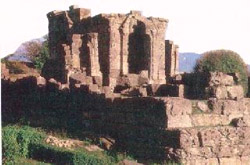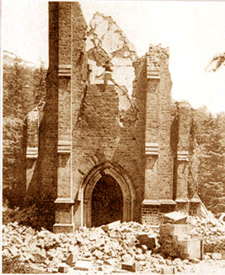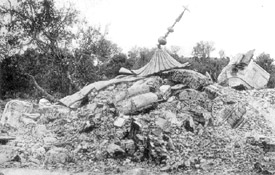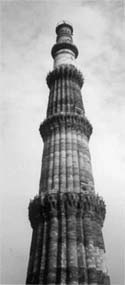Nov 19, 2025
Nov 19, 2025
Our ancestors have left behind a rich cultural heritage in the form of rock cut caves, monuments, Buddhist Stupas, mosques, minarets, temples and forts. Time and again these have been threatened and often damaged by natural hazards like an earthquake. These obelisks are constant reminders of the ingenuity of our ancestors and a journey across them speaks volumes about the rich cultural history of the nation. The turmoil within the earth is a continuous natural phenomenon. One can understand the agony of the earth by the fact that on an average whereas, a Great earthquake occurs once a year, nearly 9000 earthquakes of Very Minor category shake the earth daily. It is but natural that the trembling earth affects all the monuments, buildings and structures erected. The damage to these is dependent on the stability, design and location of the structure. Depending on the intensity of earthquakes our country is divisible into four earthquake zones. Zone II has shaking equivalent to intensity VI or less, in Zone III expected intensity is VII, Zone IV has expected intensity VIII and zone V has expected intensity IX and above. It was nearly 120 million years ago (ma) that Indian continent broke off from Africa and Antarctica and started moving northwards like a Noah's Arc and around 20 ma this continent started to collide with the Asian continent. Collision of these continents or Plates is an ongoing process and the areas near the Plate boundaries are most vulnerable to major earthquakes. Thus areas falling in parts of J&K, Himachal Pradesh, Uttaranchal, north-eastern Himalayas and Kuchh in Gujarat are marked as those falling in the Zone V of earthquakes. Although from the historical records it is well established that Zone V is at the top of hazardous areas in the matter of earthquakes, the Zone IV covering Delhi, remainder of The Himalayan states and Gujarat is no less vulnerable. A systematic study carried out by the geologists of the Geological Survey Of India (GSI) of 50 monuments located in various geomorphic and seismic zones of the country presents a gloomy picture of the condition and vulnerability of the cultural relics. The study poignantly reveals that 75 per cent of the monuments falling in the Zone V of the earthquakes have already been damaged to quite an extent by the tremors. The Himalayan Kingdom Similarly, earthquakes have not spared Malinithan Temples (8th century A.D.) in far off Arunachal Pradesh and Sibsagar Temple (1734) of Upper Assam. The earthquakes have not spared even the relics of the Peninsula. On September 1, 1803, an earthquake at Mathura jolted Delhi as well and brought the top two storeys of the Kutbminar (1200 A.D.) tumbling down. Delhi falls in the Zone IV of earthquakes. The study carried out by the GSI reveals that nearly 50 percent of the monuments in zone have suffered considerable damage from the earthquakes. The Zones III and II of the earthquakes have largest numbers of monuments. Intensity of earthquakes being lower in these parts the damage to the monuments has been minimal. Perhaps our ancestors had knowledge about 'safer zones'! Analysis N.K. Mandwal, an expert on seismology and an ex Director of GSI concludes in a paper presented on Kangra Earthquake Centenary seminar organized by the GSI that 75% monuments of Zone V have been damaged by the earthquakes. In Zone IV the damage is restricted to 50% monuments and in the Zones III and II only 11% of the monuments have been harmed by the earthquakes. It has also been observed by him that monuments located near the Plate boundaries, e.g. Kashmir, Uttaranchal, Himachal Pradesh and North Eastern Region are mostly founded on lose residual soil or glacial residues. Such foundations are prone to heavy damage. On the contrary many of the temples of the Peninsula are situated on solid rock and they have remained comparatively safe. Though, in the regions of earthquake epicenter clusters at Dharwar, West Coast, Chitradurga and Cuddapah some monuments have suffered severe damage. Safety Saves It is apparent that the monuments in the earthquake Zone V and IV are most vulnerable. Government agencies make lots of efforts to conserve these monuments with a high priority on keeping on check the action of weathering agencies and disintegration of construction material. Since a major earthquake strikes after a considerable lapse of time, the human memory fades in between and often precautions against earthquake damage are forgotten. Precautions against these thus remain a low priority. After an earthquake damage surveys are immediately carried out. Since the area to be covered is vast, often minor damages are overlooked, which could become a major irritant in case of a powerful aftershock. For example, the pillars supporting the heavy door of the sanctum sanctorum of the main temple at Jageshwar in Uttaranchal had developed cracks during an earlier earthquake. Thereafter the pillars were supported with heavy duty angle iron frame. After the Chamoli earthquake of 1999, wide gaps appeared between the frame and the masonry pillars noticed by this author in 2001. Another major earthquake can bring down this 7th century architectural marvel. Prior to construction of a dam or any other such large civil engineering structure a seismo-tectonic evaluation of the area within a radius of 100 to 300 km around the project is carried out. Depending upon the vulnerability and antiquity of a monument, similar surveys could be carried out to take preventive measures against the worst. Many of the monuments, especially the temples are still used as places of worship. An earthquake during a congregation of pilgrims could cause a major disaster. In order to prevent a major mishap, the GSI report recommends instrumentation like tilt meters to measure the slope movement and piezometers to work out pore-pressure due to soil water around the monuments. Such instruments forewarn to some extent about an impending damage. No doubt such a study involves lots of money but the cost is nothing compared with the priceless cultural value of these obelisks. Save the monuments against earthquakes to safeguard our cultural heritage.

Ruins of Avantipur
Image courtesy : indiantemplesportal.comBetween 8th and 13th centuries the Himalayan kingdoms of Uttaranachal, Jammu & Kashmir, Himachal Pradesh and Arunachal Pradesh witnessed a spurt in temple construction activity. For example, Avantipur temple close to Srinagar in J&K although in ruins still proclaims the architectural skill of the people of ancient Kashmir. It is unfortunate that invaders and earthquakes completely destroyed these temples.
Uttaranchal has some of the historical temples like Jageshwar group pf temples near Almora, constructed between 7th and 10th centuries A.D. has witnessed several earthquakes since it came in to being. Past tremors have tilted a part of upper portion of the main temple. Apart from Jageshwar temples, Baijnath Temple (8th to 13th centuries A.D.), Dwarahat Temples (11th to 13th centuries A.D.) and Pandukeshwar Temple (8th to 13th century A.D.) have been damaged badly. The devastating Kangra earthquake of 1905 severely damaged the Kangra Fort built in 470 A.D. along with St. John's Church (1852) of Mc Leod Gunj near Dharamshala in Himachal Pradesh. The Pioneer dated April 20, 1905 report on the earthquake read as, 'Golden Temple at Kangra looked like a confused mass of masonry'. In 1986 the masonry blocks at the top of St. John's Church were once again displaced as a consequence of Dharamshala earthquake.

Damaged Church at Dharamshala
Image courtesy: GSI
Golden Temple, Kangra:
A confused mass of masonry
Image courtesy: GSI The Peninsula
The Peninsula
16-Apr-2006
More by : V. K. Joshi (Bijji)

|
My Phd topic is as such"'Traditional measures to protect the Indian historical places of worship from earth quake" will u help me to give some data about this. |